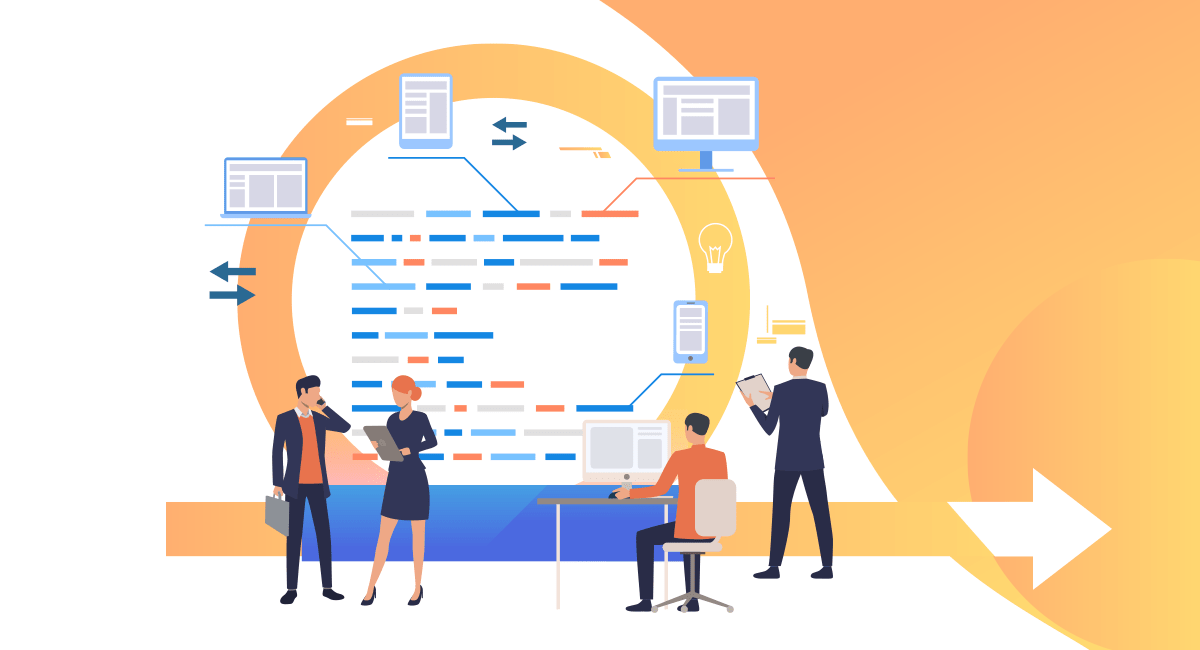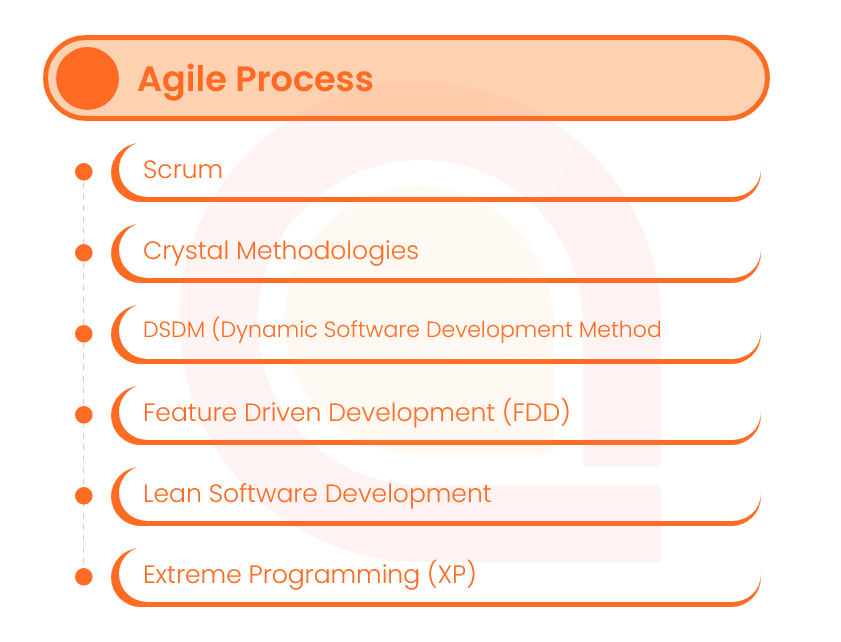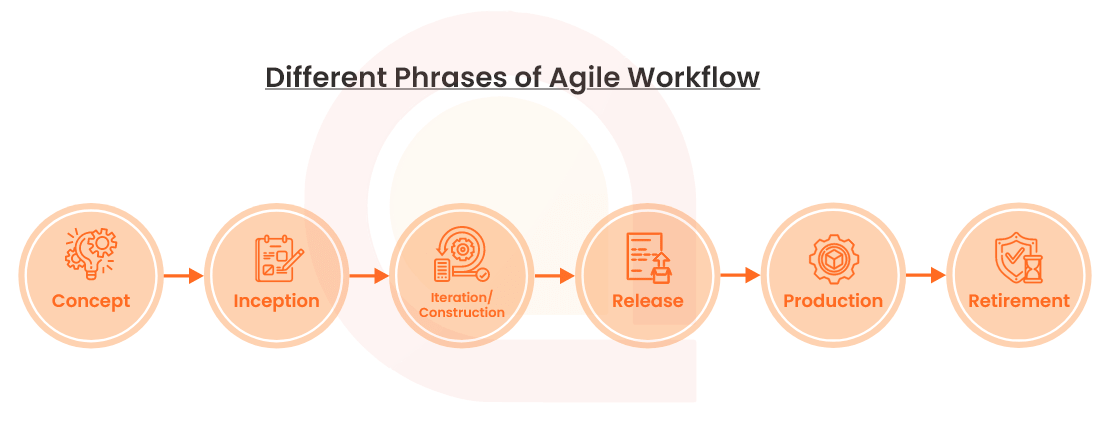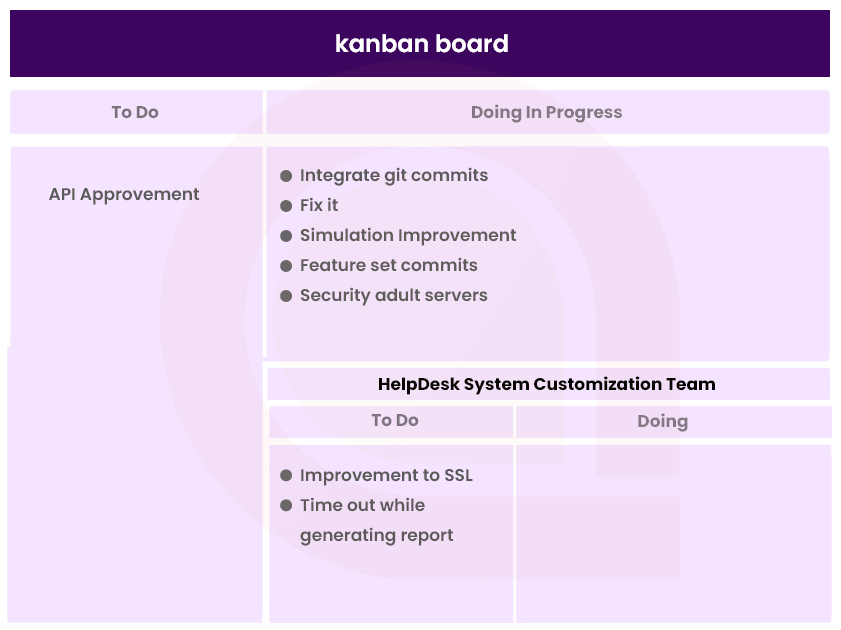Agile SDLC: Guide to Help You Make Smart Choice for Your Next Project

On-time software development delivery is one of the most common challenges most development companies are facing these days. Hence they need a flexible development methodology that helps them to develop and deliver projects on assigned time. And agile methodology offers them great flexibility in a fast-paced environment, helping them cater to their client’s requirements. Explore Agile SDLC guide to make an intelligent choice for your subsequent project development.
Implementing an Agile software development life cycle approach can provide you with numerous benefits that you have never thought of before. The methodology approaches the continuous innovations that preponderate in the development cycle. It makes it easier for MEAN stack, Android, or other team developers to deliver the project on time.
[toc]
However, the development methodology also makes it easier for your team to launch updates more frequently. Numerous reasons justify why you must opt for an agile methodology for your project development. Let’s check more about Agile SDLC, different phases, project management software, and much related to the concept.
What is Agile SDLC?
The Agile SDLC approach is an adequate and efficient process to turn your dream project into an engaging software solution. The term is appropriated to represent the project development process that includes understanding, advancement, team cooperation, evolutionary expansion, planning, and on-time delivery.
Agile project development promotes flexible acknowledgments to change. The development highlights diverse values, including:
Easy interactions with tools and methods;
Fast working with significant documentation;
Cooperation over discussion;
Let’s understand how Agile methodology strives to provide you with flexibility and speed for your software development life cycle.
Agile SDLC Process:
Check the below diagram to have a quick glimpse to Agile SDLC right away:

You come across different processes when you choose the agile SDLC approach for your project development. It helps you develop, test, and deliver the project on the assigned time duration.
Different Phrases of Agile Workflow
Are you planning to develop courier delivery software? Want to get delivered on time? Then it becomes crucial for you to choose a methodology. You can go for Agile methodology as it includes various moves that ensure to provide you with the best solution ever. The primary purpose of each step is to help you generate excellent output that meets all requirements efficiently. Explore the agile workflow diagram right away:

Agile workflow mainly comprises different steps that make your development and testing work much easier and faster than ever before. Different steps have their importance, helping you satisfy various p[project development needs efficiently.
Check Different Type of Agile Methodology to Make Smart Choice
The agile approach anticipates the necessities for versatility and utilizes a level of sedation to the finalized software. The method demands a cultural shift in various companies as it primarily muses on the precise offering of particular portions of your project, not the entire apps.
Agile SDLC makes it easier for you to welcome changes entirely in the development approach. However, it also makes it quite flexible for you to produce working software on your client’s requirements. There is a various agile methodology that is widely used by individuals these days, these includes:
1) Kanban
2) Scrum
3) Extreme Programming (XP)
4) Crystal
5) DSDM (Dynamic Systems Development Method)
6) Lean
7) FDD (Feature-Driven Development)
Let’s understand each one in-depth, helping you make an intelligent choice for your subsequent project development.
1. Kanban
Kanban is a manageable and visible means of handling project development. It enables the team to check the ongoing process and plan the further strategy accordingly. All the projects of Kanban are efficiently managed with the Kanban board; the segment includes different columns like:
- To Do
- In-Progress
- Done

Kanban Practices
The Kanban methodology is primarily based on six techniques to build an effective combination of fundamental systems in the company and gain more beneficial agility in the requirement of services. These methods must be reviewed, enhanced, and reviewed to improve the development process.
- Visualize;
- Ultimate work in progress;
- Control development flow;
- Establish policies explicitly;
- Execute review loops;
- Advance collaboratively and emerge empirically.
Kanban is a practical development approach that provides a perpetual enhancement for the work process. However, the process is exceedingly determined by practice speculation. Hence it accommodates beginning performances from the conception of a system with some practical practices.
Pros & Cons of Kanban
| Pros | Cons |
|---|---|
| Ease of use | Can’t be used independently |
| Promotes constant and sustainable improvements in the different functions | Does not fit into a dynamic environment |
| Flexibility | The weakness for an iteration |
| Collaboration | Reduction of timing |
| Decreases detriments and wastage | |
| Low Depreciation |
2. Scrum
Scrum is quite similar to Kanban in a few or other ways. The development approach practices a Scrum board. The functionality of the Scrum board is pretty related to a Kanban board. The group’s responsibilities into strings based on development. The development approaches mainly concentrate on divulging software down into sprints. It enables you to plan and manage only one portion at a particular time.
Scrum Practices
Managing optimal Celerity means the Scrum Team consistently and immediately works towards enhancing the utility of the customer. It helps the team perform probably, assuredly, and on the other hand, it helps you complete one project after the other.
It introduces a manageable way of working that can immediately devolve into herding kittens if the team is not using the best practices to accomplish their work. The scrum practice includes the following things:
- Promote peer-to-peer cooperation;
- Continually improve performance in Scrum events;
- Build translucent Scrum artifacts for examination and modification;
- Automate methods to stimulate enterprise-level actions.
Pros & Cons of Scrum
| Pros | Cons |
|---|---|
| Easy to rectify and remove mistakes | Strict governance can attend to the breakdown of the complete project |
| The permissive perceptibility of all stages of the process | If any member left the project in between then it can have a negative impact |
| It makes it easier to cope with changes that are required | No deadline can creep to scope creep and keeps project managers demanding new functionalities |
| The methodology helps the team to welcome changes at any stage without hassle | Requires strong commitment |
| Scrum methodology guarantees the most reliable results. | Suitable for teams that have great understanding and cohesion |
3. Extreme Programming (XP)
Extreme Programming was composed for project development. It concentrates on perceptual development and practices sprints related to a Scrum approach. However, extreme programming also has around twelve promoting methods particular to the world of project development.
Extreme Programming (XP) Practices
Extreme Programming methods are particular guidelines and practices. Whereas the benefits and teachings granted are also used in various methodologies. The specific practices of XP are the features differentiation of the method. They have improved slightly and diversified based on the evidence you advise. XP practices are primarily device in four areas, including:
- Accurate scale feedback
- Constant method
- Shared perception
- Programmer welfare
- Uses positions to assign responsibilities and abilities
Pros & Cons of Extreme Programming (XP)
| Pros | Cons |
|---|---|
| Close contact with the customer | Additional work |
| No unnecessary programming work | Consumer must participate in the method |
| Stable software through continuous testing | Relatively great time investment |
| Error escape through pair programming | Comparatively high-priced |
| No overtime, teams can work at their pace | Needs version management |
| Modifications can be made at short notice | Needs self-discipline to function |
| Code is clear and comprehensible at all times |
4. Crystal
Crystal is one of the well-known approaches that is recognized as a lightweight procedure that mainly focuses on intercommunications. The approach works efficiently for a single workspace. Crystal methodology mainly includes different variants, including
- Crystal Clear;
- Crystal Yellow;
- Crystal Red;
- Crystal Orange.
Crystal Practices
Crystal practices consist of different practices from which few are mandatory while few are not. Crystal practices simple include the following;
- Expected delivery
- Contemplative betterment
- Osmotic interaction
- Personal protection
- Focus on business
- Introduction to subject matter experts and users
- Technical tooling
Pros & Cons of Crystal
| Pros | Cons |
|---|---|
| Adaptable framework as per the requirements of the team | No unyielding structure can blend freshers |
| More reliable responsiveness to transforming environments | No specification about online interaction or virtual teams |
| High level of transparency and responsibility | Blocks the more significant picture due to the absence of determined plans |
| Team members have sovereignty over the obligation | Less documentation and supervision can cause unfair payment |
| Direct communication and lesser management |
5. DSDM (Dynamic Systems Development Method)
The DSDM came into existence due to the expanding obligations for the standard industry framework for effective performance. Revision is required when generating innovations that are reversible. DSDM also considers using spirits just like other development methodologies.
DSDM (Dynamic Systems Development Method) Practices
- Focus on the business requirement;
- Deliver on time;
- Cooperate;
- Nevermore understanding character;
- Develop incrementally from firm associations;
- Strengthen iteratively;
- Breathe continuously and precisely;
- Unmistakable switch.
Pros & Cons of DSDM (Dynamic Systems Development Method)
| Pros | Cons |
|---|---|
| Software development on time | Extensive management overhead |
| The development approach ensures great flexibility | The costly implementation makes it unsuitable for small brands to choose the development approach |
| Easy to understand process across different brands | DSDM can be restrictive and inhibit developer creativity. |
| DSDM model ensure delivered software have real value | Software needs to be completed as per specified requirement |
6. Lean
Lean methodology is associated with the Agile SDLC approach, but it has different practices than other development approaches.
Lean Practices
There are few essential practices that you can consider when it comes to lean development methodology, these includes:
- Reduces development wastage;
- Helps to develop quality;
- Build knowledge;
- Deliver quality and effective results;
- Optimize the whole development process.
Pros & Cons of Lean
| Pros | Cons |
|---|---|
| Less waste | Lack of time |
| More focus | A deficiency of strategy |
| Better motivation | Not enough buy-in |
| A smarter way of working | Cutting things too fine |
| More value for the customer |
7. FDD (Feature-Driven Development)
Project-specific agile framework, FDD involves developing software models making the API development and other development tasks much easier for developers. It demands you design and develop a software development strategy that ensures the release of the best product ever. It has accurate documentation needed for Extreme Programming. This approach is the best option, especially when you are looking for advanced development abilities.
FDD Practices
- Build an overall pattern;
- Create a list of functionalities;
- Design and develop as per functionalities.
Pros & Cons of FDD (Feature-Driven Development)
| Pros | Cons |
|---|---|
| Provides a good knowledge of the project’s scope and context | FDD is not an absolute choice for smaller projects |
| Needs fewer meetings | Reservations a high dependency on a leading programmer |
| Practices a user-centric approach | Maintains individual code control instead of shared team control |
| Works efficiently with large-scale projects and team | |
| Breaks feature collections into chunks and constant iterative statements |
Pros and Cons to Apprehend About Agile Development Approach
The agile development approach offers excellent attributes to the team in emerging panorama while advancing focus on the practical delivery of preference. However, the collaborative culture of this methodology facilitates enhanced efficiency throughout the business as partners operate together and realize their particular tasks in the method. Let’s check more advantages as well as disadvantages of agile methodology right away.
Pros and Cons of Agile Development Approach
| Pros | Cons |
|---|---|
| More flexible | Hard to predict |
| Product get to market faster | The final product is not released first |
| Better communication | Documentation gets left behind |
| Responding to change | Lack of understanding |
| Less defective products | Flexibility can lead to harmful behaviors |
| Immediate feedback | Lack of predictability |
| Accepting uncertainty | Integrating diverse skill sets into teams |
| Greater flexibility in releasing features | A lot amount of required to complete one project |
| Less up-front work | Stressful when it comes to the reality of producing solutions for the public |
These days, most companies use an agile development approach, helping them stay self-sufficient and deliver high-quality products. Agile methodology and best tools choice make it easier for developers to launch bug-free and effective working software than ever before.
How Agile & Traditional SDLC Differs from Each Other?
Difference Between Agile & Traditional SDLC
| Agile | Traditional SDLC | |
|---|---|---|
| Model principle | The agile model is flexible and can quickly adapt the software to the customers’ requirement | Traditional models lack flexibility, making it challenging to make changes in the project during the development cycle |
| Project size | Best choice for all sizes projects | Used for all sizes of project, but makes bit allowance for human errors |
| Success measurement | Success is measured by delivering high-quality software | Success is measured by conformity to the initial plan |
| Adaptability | Changes are allowed at every stage | It’s a bit hard to make changes during the development cycle |
| Documentation | The agile methodology doesn’t demand great documentation | Intensive documentation is required in the traditional SDLC model |
| Iteration Cycles | Has several iteration cycles | Has limited iterations cycle |
| Original Planning | Minimal planning is required at the pre-development phase | Planning need to completed before the beginning of the development cycle |
6 Best Agile Project Management Softwares
Agile Project Management Softwares
| Software | Ratings | Price | Download |
|---|---|---|---|
| Active Collab | 4.5/5 | $6.25/month/user | Get it Now |
|
Pros:
Intuitive and outstanding support |
Cons:
Timeline and column views for tasks rather than Gantt. |
||
| Agilo For Trac | 3.3/5 | €10/month for unlimited users | Get it Now |
|
Pros:
A comprehensive integration system, active support team, and well-priced |
Cons:
Can enable to host one project only |
||
| Pivotal Tracker | 4.1/5 | Monthly flat rate of $10 for up to 10 collaborators | Get it Now |
|
Pros:
Great specifically for project development, lots of integrations, and support cross-functional teams |
Cons:
Support can be hindered for non-paying users |
||
| SprintGround | 5/5 | $29.00/month | Get it Now |
|
Pros:
Great for project development, encourages customer-specific software development, and has numerous traditional functions |
Cons:
Documentation storage is restrained regardless of which plan you choose |
||
| Targetprocess | 4.5/5 | Free for up to 1,000 entities | Get it Now |
|
Pros:
Impressive and unique design that’s great |
Cons:
Charges $150 per hour for training on how to use the product for “free” |
||
| VersionOne | 4.1/5 | $29.00/month/user | Get it Now |
|
Pros:
Easy to use and best choice for remote teams |
Cons:
Remarkable features and the free version is limited |
Is Agile Methodology Best for Your Next Project?
Before choosing any development methodologies, you need to make sure that you go through its practices, pros, and cons. Also, make sure to look at the realities of the software you are thinking of developing. To achieve success with Agile, you need to follow every step efficiently, helping you to build excellent performing software in no time.
However, when you think of developing a project, make sure to implement agile methodology within it. Our dedicated team of developers is always here to help you with your development task; get a quote to get all your queries solved immediately. We are always there to provide you with excellent support; hence contact us if you have doubts.
Frequently Asked Questions
1. When is it best to use Agile methodology?
An agile approach is the best option, especially when the functionalities and features of the project are undefined. The methodology enables product owners to adjust priorities and needs along the way to leverage the advantages of possibilities and ultimately deliver a better product to all customers.
2. Is the Agile process only used for the development process?
No. You can implement an agile approach in any area of your business. Developing an agile co-working space can benefit your business in the long run.
3. What are the problems faced in the developing model?
There are numerous challenges that developers face during the development process. These includes
- Interaction with the team;
- Supervise day to day operations;
- Changing customer preferences;
- Gain experience and make it work.
4. Which is the most inventive and challenging phase of the system life cycle?
One of the most inventive and challenging phases of agile SDLC is design. Also referred to as technical specifications.
